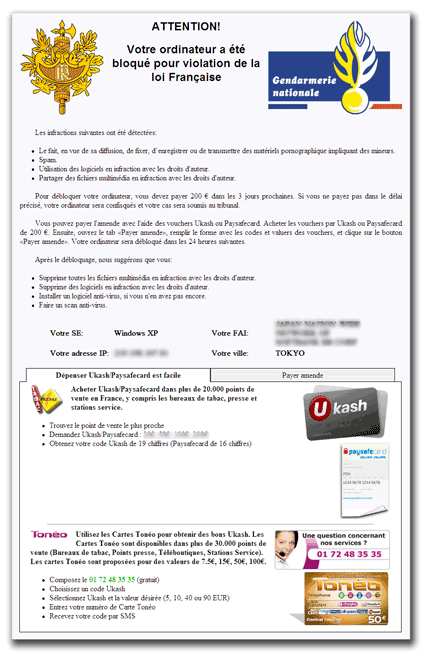TROJ_RANSOM.BOV
Trojan:Win32/Ransom.FL (Microsoft)
Windows 2000, Windows XP, Windows Server 2003


Threat Type: Trojan
Destructiveness: No
Encrypted: Yes
In the wild: Yes
OVERVIEW
Downloaded from the Internet
This ransomware was spread via a compromised website of a well-known confectionery company based in France, Laduree.
To get a one-glance comprehensive view of the behavior of this Trojan, refer to the Threat Diagram shown below.

Upon execution, this Trojan connects to a certain site to get the IP address, geographical location, city, and Internet Service Provider (ISP) of the affected system. It then blocks the desktop of the user and displays an image. The image accuses the user of violating the laws of France for several fabricated offenses. It then demands users to pay a fine via Ukash or Paysafecard voucher.
This Trojan may be unknowingly downloaded by a user while visiting malicious websites.
TECHNICAL DETAILS
Varies
EXE
Yes
21 Feb 2012
Displays graphics/image
Arrival Details
This Trojan may be unknowingly downloaded by a user while visiting malicious websites.
Installation
This Trojan drops the following copies of itself into the affected system:
- %Windows%\explorer.exe
- %System%\explorer.exe
(Note: %Windows% is the Windows folder, which is usually C:\Windows.. %System% is the Windows system folder, which is usually C:\Windows\System32.)
Process Termination
This Trojan terminates the following processes if found running in the affected system's memory:
- taskmgr.exe
- procexp.exe
NOTES:
Upon execution, it connects to the following site to get the IP address, geographical location, city, and Internet Service Provider (ISP) of the affected system:
- http://{BLOCKED}ls.{BLOCKED}location.com/ib2/
It then blocks the desktop of the user and displays the following image:

The image above accuses the user of violating the laws of France for several fabricated offenses. It then demands users to pay a fine via Ukash or Paysafecard voucher.
It reports system infection to any of the following sites:
- {BLOCKED}wuusaf.com
- {BLOCKED}rpeprt.ru
- {BLOCKED}sxppsy.com
- http://{domain}/{BLOCKED}e.php?cmd=ping&botnet={parameter}&userid={encoded user ID}&os={encoded operating system version}
It saves the original explorer.exe file as follows:
- %Windows%\twexx32.dll
SOLUTION
9.200
8.792.08
21 Feb 2012
8.793.00
22 Feb 2012
Step 1
Before doing any scans, Windows XP, Windows Vista, and Windows 7 users must disable System Restore to allow full scanning of their computers.
Step 2
Scan your computer with your Trend Micro product to delete files detected as TROJ_RANSOM.BOV. If the detected files have already been cleaned, deleted, or quarantined by your Trend Micro product, no further step is required. You may opt to simply delete the quarantined files. Please check this Knowledge Base page for more information.
NOTES:
Do as Step 2:
To identify and delete the malware/grayware file:
- Insert your Windows Installation CD in your CD-rom.
- Press the restart button of your computer.
- When prompted, press any key to boot from the CD.
- When prompted on the Main Menu, type r to enter the recovery console.
(Note: On Windows 2000, after pressing r, type c to choose the Recovery Console in the repair options screen.) - When prompted, type your administrator password to log on.
- Once logged in, type the drive that contains Windows in the command prompt that appears, then press Enter.
- Type the following, then press Enter:
del %Windows%\explorer.exe
del %System%\explorer.exe
copy %Windows%\twexx32.dll %Windows%\explorer.exe
del %Windows%\twexx32.dll
- Type exit to restart the system normally.
Did this description help? Tell us how we did.


